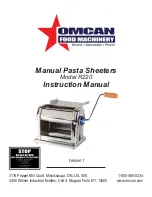
36
37
T
roub
leshooting
Troubleshooting
Before calling for service, please check through this section.
Problem
Cause
Action
My bread does not rise.
The top of my bread is
uneven.
The quality of the
gluten in your flour is poor, or you have not used strong flour.
(Gluten quality can vary depending on temperature, humidity, how the flour is
stored, and the season of harvest)
Try another type, brand or another batch of flour.
The dough has become too firm because you haven’t used enough liquid.
Stronger flour with higher protein content absorbs more water than others, so try
adding an extra 10-20 ml of water.
You are not using the right type of yeast.
Use dry yeast from a sachet, which has ‘Easy Blend’, ‘Fast Action’ or ‘Easy Bake’
written on it.
This type does not require pre-fermentation.
You are not using enough yeast, or your yeast is old.
Use the measuring spoon provided. Check the yeast’s expiry date.
The yeast has touched the liquid before kneading.
Check that you have put in the ingredients in the correct order according to the
instructions, adding the water and liquids last of all. (P.8)
You have used too much salt, or not enough sugar.
Check the recipe and measure out the correct amounts using the measuring
spoon provided.
Check that salt and sugar is not included in other ingredients.
My bread is full of air
holes.
You have used too much yeast.
Check the recipe and measure out the correct amount using the measuring
spoon provided.
You have used too much liquid.
Some types of flour absorb more water than others, so try using 10-20 ml less
water.
My bread seems to
have collapsed after
rising.
The quality of your flour isn’t very good.
Try using a different brand of flour.
You have used too much liquid.
Try using 10-20 ml less water.
My bread has risen too
much.
You have used too much yeast/water.
Check the recipe and measure out the correct amount using the measuring
spoon (yeast)/cup (water) provided.
Check that excess water amount is not included in other ingredients.
You have not used enough flour.
Carefully weigh the flour using scales.
Why is my bread pale
and sticky?
You are not using enough yeast, or your yeast is old.
Use the measuring spoon provided. Check the yeast’s expiry date.
There has been a power failure, or the machine has been stopped during
breadmaking.
The machine switches off if it is stopped for more than ten minutes. You will need
to remove the bread from the pan and start again with new ingredients.
There is excess flour
around the bottom and
sides of my bread.
You have used too much flour, or you are not using enough liquid.
Check the recipe and measure out the correct amount using scales for the flour
or the measuring cup provided for liquids.
Problem
Cause
Action
Why has my bread not
mixed properly?
You haven’t put the kneading blade in the bread pan.
Make sure the blade is in the pan before you put in the ingredients.
There has been a power failure, or the machine has been stopped during
breadmaking.
The machine switches off if it is stopped for more than ten minutes. You might be
able to start the loaf again, though this might give poor results if kneading had
already begun.
The kneading mounting shaft in the bread pan is stiff and does not rotate.
If the kneading mounting shaft does not rotate when the blade is attached,
you will need to replace the kneading mounting shaft unit (consult the place of
purchase or a Panasonic service centre).
My bread has not been
baked.
The ‘DOUGH’ option was selected.
The ‘DOUGH’ option does not include a baking process.
There has been a power failure, or the machine has been stopped during
breadmaking.
The machine switches off if it is stopped for more than approx. ten minutes. You
can try baking the dough in your oven if it has risen and proved.
There is not enough water and the motor protection device has activated. This only
happens when the unit is overloaded and excessive force is applied to the motor.
Visit place of purchase for a service consultation. Next time, check the recipe and
measure out the correct amount using the measuring cup provided for liquid and
scales for weighing flour.
Dough leaks out of
the bottom of the
bread pan.
A small amount of dough will escape
through the four holes (so that it does
not stop the rotating parts from rotating).
This is not a fault, but check occasionally
that the kneading mounting shaft rotate
properly.
If the kneading mounting shaft does
not rotate when the blade is attached,
you will need to replace the kneading
mounting shaft unit (from the place
of purchase or a Panasonic service
center).
Dough release
holes
(4 in total)
(Bottom of bread pan)
Kneading mounting shaft
Kneading mounting
shaft unit
Part no. ADA29A115
The sides of my bread
have collapsed and the
bottom is damp.
You have left the bread in the bread pan for too long after baking.
Remove the bread promptly after baking.
There has been a power failure, or the machine has been stopped during
breadmaking.
The machine switches off if it is stopped for more than ten minutes. You may try
baking the dough in your oven.
The kneading blade rattles.
This is because the blade fits loosely on the shaft. (This is not a fault)
I can smell burning while
the bread is baking.
Smoke is coming out of
the steam vent.
Ingredients may have been spilt on the heating element.
Sometimes a little flour, raisins or other ingredients may be flicked out of the
bread pan during mixing. Simply wipe the element gently after baking once the
breadmaker has cooled down.
Remove the bread pan from the breadmaker to place ingredients.




































